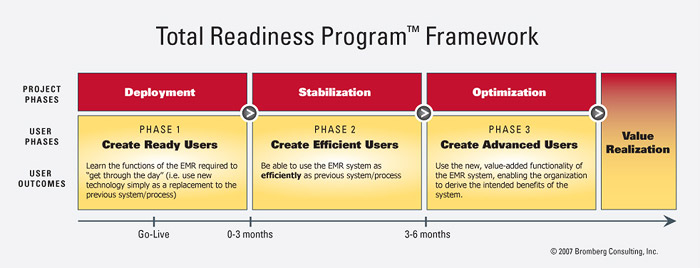It Starts at Go Live
view as PDF
Ten Readiness Strategies Every Leader Should Know About Implementing an Electronic Medical Records System.
The strategies presented in this paper are based on actual feedback from a wide spectrum of end users and key stakeholders involved in dozens of EMR implementations including inpatient, outpatient and practice management. go
#1. Acknowledge that 'Go-Live' is just the beginning.
Most large scale technology implementations are centered on the system itself, ensuring the hardware, software and other components are fully operational. Training is often delivered in a general fashion, more concerned with basic feature orientation than with specific user issues and requirements.
Experience with technology adoption shows that over time, most users of any new system become more skilled at using the functionality they were initially taught, yet do not advance their knowledge without additional training or intervention. This is exacerbated with Electronic Medical Systems, where the user population is diverse in their education, skills and responsibilities. As such, training presented in the context of the user’s role in the organization is key.
We define three stages of user proficiency – Ready User, Efficient User and Advanced User. These user phases coincide with the overall project phases and require a comparable level of planning and implementation.
Successful EMR launches are built on the recognition that ‘go-live’ is not the culmination, but the beginning. The first time a clinician uses the system with a live patient is when adoption truly starts. It is what follows in ongoing acceptance, understanding and utilization where the real value can be achieved and transformation can occur.
#2. Create a comprehensive People Readiness Plan.
For new users go-live is the beginning – the point at which all of the preparation comes together and the task of learning how to do their jobs in a new way begins. Multiple levels of user proficiency need to be acknowledged, defined and accommodated in a pro-active plan that introduces them to additional features, functions, short cuts and other content. This proactive planning will move them from Ready to Efficient and ultimately Advanced Users.
Readiness is not achieved by training alone; it is achieved by a comprehensive plan that includes leadership support, clear communication, change management and user-specific training. The perspective of labor and other key departments that are involved and affected must be included. With a People Readiness Plan, users can be moved through all phases of the implementation for efficient use of the system and full realization of the anticipated benefits.
#3. Provide training that is user-centric, not system-centric.
End users are interested in how the implementation of an EMR system will impact them and the way they do their jobs. A common theme that surfaced in hundreds of end user interviews was that training needs to be job-specific. Most training is too general, and while it provides a solid foundation of how the system works, it does not prepare the end user to specifically do his or her job. Most commonly the material delivered to users is system-centric, designed and presented by personnel who are experts on the EMR system, and not user-centric, based on use of the system in the context of roles and job responsibilities.
Users want and need to know the exact aspects of the EMR system required of their jobs, mapped to existing workflows, processes and other systems. Essentially, all they need to know and nothing they don’t. The most effective training will take a user-centric approach.
#4. Ensure user readiness prior to go-live.
Creating a “ready user” is a complex task that requires far more than simply training – it requires a balanced focus on the various aspects involved: training, change management, communications, labor representatives and others. Going from paper to EMR requires a different set of activities than replacing one EMR system with another. Additionally, it is important for the leadership team to understand the importance of defining readiness specifically so that everyone has a clear definition of what they are trying to achieve and progress can be measured.
Go-live is a stressful experience, with a direct correlation between the success of the implementation and the degree to which the user was ready for the change. Characteristics of a ready user include:
- Basic computer skills and comfort with technology
- Familiarity with the basic functionality of the EMR
- Understanding of impact on current workflows
- Awareness of available help resources and willingness to use them when needed
- A positive attitude, openly conveyed throughout the implementation
It is optimal for organizations to develop a comprehensive definition of user readiness early in the implementation. This will provide the framework to ensure that each team member understands their important role in creating ready users.
#5. Engage managers and supervisors early.
A key success driver in the entire implementation process is the early engagement of managers and supervisors. Motivated and enabled supervisors can provide a very positive role in their staff’s go-live experience, adding value in many ways, including:
- Department-specific input into the development of system configurations, content and workflows.
- Department-specific input into the development of communications, training and other launch activities.
- Providing support and making business and work flow decisions.
- Being able to credibly empathize with, and help to resolve, issues within their group.
- Demonstrating genuine enthusiasm, which almost always is transferred to users.
Managers and supervisors can be the best friends of an EMR implementation. As the first line of contact, they will be crucial to managing change, buffering issues and addressing legitimate concerns during rollout and beyond.
#6. Involve Operations in all aspects of implementation.
A common issue in most large-scale technology implementations is that the technology – getting the system installed and functioning – becomes the primary focus of the organization and the key responsibility for project teams tasked with installation. However, the value of the technology and the benefits to the organization are only realized through actual day-to-day use by the rest of the organizational departments and staff. Therefore, it is crucial that operations take an active lead or a partnership role in addressing end-user concerns and requirements. The implementation team brings the needed expertise and know-how of the technology, and can recommend the right sequence and level of feature orientation. Over time, when the system is fully deployed, it is the synergy between operations staff and the end users that will enable positive transformation.
#7. Evaluate ‘big bang’ or phased implementation approach.
While a variety of implementation approaches exist, two of the most common are a “big bang” approach where implementation happens across all facilities and departments almost simultaneously, and a “rolling or phased” approach where deployment is staggered over time. Obviously, a big bang approach is an enormous challenge, requiring intense focus and presenting risk for large organizations with multiple facilities by eliminating the ability to evaluate and apply learnings from early implementations to subsequent launches.
Using a big bang approach can result in several valuable benefits:
- Complete organizational focus that promotes rapid learning and problem resolution.
- Elimination of the complexities and confusion when dissimilar systems are used in parallel.
- With all users on the same system at the same time, dialogue and sharing is more efficient.
- Internal complaints and resistance to change are reduced because everyone is going through the process at the same time, increasing a spirit of teamwork.
If organizational circumstances dictate a phased implementation approach, there are several things to keep in mind:
- Pilot sites, used to validate implementation details and to serve as a learning mechanism, can be extremely effective.
- It is optimal to deploy an entire facility (or logical geographic or departmental site) at one time, to minimize miscommunication, confusion and potential inconsistencies.
- The entire project team needs to remember that each phase is essentially a separate go- live implementation, creating a stressful experience for each newly affected group of users.
#8. Demonstrate leadership commitment to project.
While departmental management support is critical, nothing helps to communicate the importance and urgency of an Electronic Medical Record (EMR) system implementation better than demonstrated leadership commitment.
Proven tactics for demonstrating leadership support include:
- Be visible during related events – leadership should be present during software demonstrations, dress rehearsals, and especially during go-live.
- Take part in training during the same sessions attended by users.
- Reinforce the implementation prominently and repeatedly in meetings and presentations.
- When possible, give the EMR project priority over other initiatives that would compete for mindshare and resources.
- Minimize distractions such as meetings during and immediately after go-live.
Our experience shows that in implementations where leaders are involved, users demonstrate a better attitude and are more committed to success.
#9. Communicate realistically.
All communication and training activities need to present realistic information that conveys not only the advantages of the new system, but also the challenges, including the more difficult functions where users may face learning or usage difficulties. Instead of just presenting the positive aspects of the implementation, effective communications will address all aspects in a realistic manner.
A Communications Plan needs to:
- Utilize a broad range of communication vehicles. With significant differences in the way different job functions perceive and utilize communications, it is important that a mixed portfolio of communication vehicles be constructed to provide multiple opportunities for the user audiences to receive the information that they need.
- Be comprehensive and complete. Prospective users want more information than just the functionality of the new system. Pre-launch communications efforts should address their broader set of needs such as the overall deployment strategy and schedule, the software capabilities, how the new EMR system will impact them and change their jobs, and much more.
- Be early and repetitious. Users prefer frequent, short, on-target communications delivered in a broad range of vehicles to build a core body of knowledge and enthusiasm that sets the stage for success.
While it is useful to generate enthusiasm and optimism, users need to have their expectations set realistically to minimize disappointment and frustration at go-live.
#10. Provide the right types of support, during go-live and beyond.
Despite the quality, amount of training and other preparations, go-live represents an extremely stressful experience for most users, making support a critically important function during the hours and days after go-live.
Support and other enabling factors can include:
- Workload reduction during the ramp-up time whenever possible.
- Staff augmentation and backfill when workload reduction is not possible.
- Plan for adequate number of support personnel at go-live with a ramp down plan after the first several days.
- Ensure support personnel have the ideal skill set which includes both experience of the user’s job and knowledge of the EMR system. When it is not possible to provide support staff skilled in both, it is useful to provide a mix of skill sets for improved collaboration.
view as PDF
The implementation of an Electronic Medical Record (EMR) system is a complex and costly undertaking. Most organizations approach this endeavor with a primary focus on the installation of the hardware and software, even though by itself the technology adds no value. It is therefore prudent for organizations embarking on an EMR implementation to broaden their focus to include a comprehensive people strategy to ensure end users are ready to use the system and deliver the benefits throughout the organization.
To learn more about Branding and what you can do to build your brand asset, contact us at 520-321-1099 or info@brombergconsulting.com.

